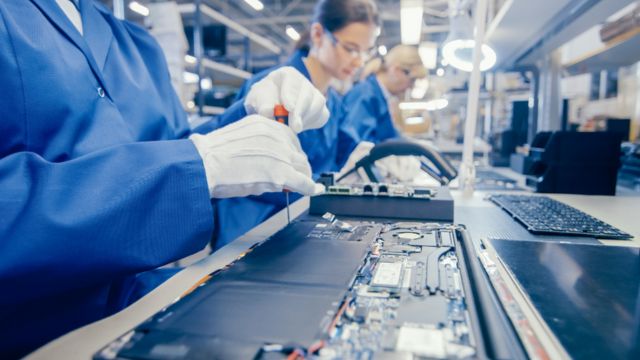Businesses in the very competitive field of medical supply manufacture are always searching for ways to save money without compromising excellent standards. Price sensitivity is only one factor influencing demand for affordable manufacturing; another is pressure to keep compliance with ever-tighter rules, guarantee dependability, and maintain consumer confidence. The difficulty is striking a balance between cost control and quality assurance such that the integrity of the product is not compromised—that could result in expensive product recalls, fines for regulations, or a damaged brand.
Medical supply companies can apply these sensible cost-cutting techniques without compromising product quality:
1. Lean Manufacturing Techniques
Lean manufacturing is a methodical process for waste reduction and higher production enhancement. Without sacrificing quality, this approach enables producers of medical supplies simplify their procedures, cut waste, and maximise resource use. Medical producers can minimise downtime, increase lead times, and cut faults by concentrating on ongoing improvement, therefore helping to save costs.
Key aspects of lean manufacturing include:
- Just-in-time production to reduce inventory costs.
- Kaizen (continuous improvement) to enhance processes and eliminate inefficiencies.
- Total productive maintenance (TPM) to prevent breakdowns and keep machinery running at optimal efficiency.
By implementing lean principles, manufacturers not only reduce costs but also improve quality control and operational efficiency.
2. Automation and Robotics
Another great approach to lower labour costs and increase manufacturing accuracy is adding robotics and automation into the production line. Automation guarantees a great degree of accuracy and consistency by helping to simplify repeated chores including assembly, packaging, and testing. Lower labour expenses and less human mistake resulting from this help to prevent human error that can produce defective goods and more waste.
Real-time monitoring of manufacturing processes made possible by automation helps to identify and fix problems early on, therefore preventing expensive blunders. Medical producers can shift resources to more value-added activities by lowering reliance on human labour, therefore enhancing both cost efficiency and general quality of products.
You may like this: Advanced Materials and Technologies Shaping the Future of Medical Manufacturing
3. Supplier Relationship Management

Reducing the cost of raw materials without compromising quality depends on solid ties with suppliers. To negotiate cheaper pricing, create long-term partnerships, and guarantee the consistent supply of excellent materials, manufacturers need closely interact with their suppliers. Furthermore immediately affecting production costs is enhanced supply chain dependability resulting from effective supplier relationship management.
Using bulk buying agreements—which sometimes let manufacturers get savings for big orders—is essential component of supplier management. Manufacturers should also routinely check their supplier performance, evaluate substitute materials, and spot chances for creative cost-cutting ideas.
4. Material Optimization
Maintaining cost-effectiveness and quality of medical supplies depends on using the correct manufacturing materials. Manufacturers should always evaluate their choice of materials and investigate more reasonably priced substitutes without sacrificing product performance. Choosing premium, reasonably priced plastic or composite materials, for instance, can help to reduce manufacturing costs without compromising the integrity or durability of the resultant good.
Furthermore included in material optimisation is production waste reduction. Manufacturers can lower scrap and waste by bettering design and production techniques to guarantee that every component of the material is used effectively, therefore immediately lowering costs.
5. Outsourcing and Contract Manufacturing
Cost-effective solutions include outsourcing some manufacturing process tasks including assembly, packaging, or specialised component manufacture. Contract manufacturing lets medical supply companies use outside partners’ knowledge, therefore lowering overhead costs and capital expenditures.
Manufacturers must so carefully select their outsourcing partners to guarantee they satisfy quality criteria and can generate parts at the necessary cost and scale. Outsourcing can also let companies profit from the cost savings of their partners while concentrating on their main capabilities.
6. Energy Efficiency and Sustainability
Investing in energy-efficient machinery, tools, and lighting systems will help manufacturers greatly lower running costs. Energy bills, a major component of running expenses, can be lowered by firms by maximising energy use throughout manufacturing plants.
Using sustainable manufacturing techniques such as cutting water use, waste material recycling, and renewable energy sources can also help the business’s sustainability profile be improved and result in long-term cost benefits.
7. Optimizing Workforce Efficiency
Reducing mistakes and increasing efficiency depend much on personnel training and upskillment. A well-trained staff is more likely to run equipment properly, follow quality standards, and spot production process inefficiencies. Training initiatives should be investments made by manufacturers to guarantee that staff members are competent in using the most recent technologies and procedures, so helping to lower waste, rework, and downtime.
By allowing staff members to play several jobs, cross-training initiatives also help to guarantee workforce flexibility and lower the demand for temporary workers.
Read also this: How IoT and Industry 4.0 Revolutionize Medical Manufacturing: Benefits, Implementation, and Challenges
8. Rigorous Quality Control and Testing
While it may seem counterintuitive to invest in quality control when trying to reduce costs, implementing effective quality assurance practices can save manufacturers money in the long run by reducing defects, recalls, and warranty claims. Rigorous testing and inspection during and after production ensure that products meet regulatory requirements and customer expectations, reducing costly post-production errors.
By incorporating statistical process control (SPC) and other quality tools, manufacturers can identify trends and potential issues early, ensuring products meet the highest standards of quality at the lowest cost.
Conclusion: Balancing Cost and Quality in Medical Supply Manufacturing
Cost reduction in medical supply manufacturing is achievable without compromising quality. By adopting lean manufacturing techniques, integrating automation, optimizing materials, and focusing on supplier relationships, manufacturers can drive down costs while maintaining or even improving product quality. Additionally, investing in workforce training, energy efficiency, and rigorous quality control measures ensures that manufacturers can maintain high standards and regulatory compliance while improving their bottom line.
At J & J Supplies, we are dedicated to provide clinical engineering solutions fit for your requirements and premium medical supplies. We provide useful information and support whether your search is for trustworthy suppliers for medical equipment or the most recent in manufacturing techniques. Keep educated and get in touch with us to investigate industry best practices!








